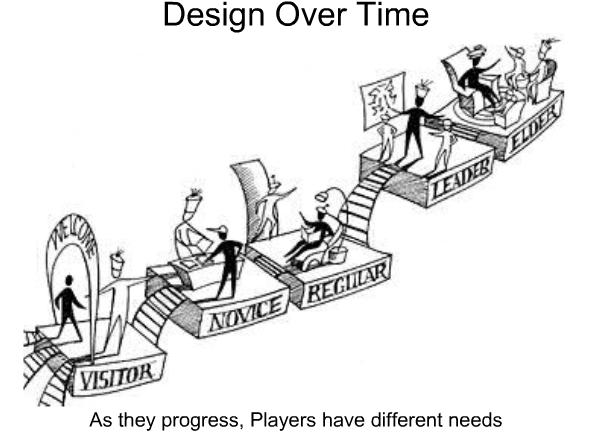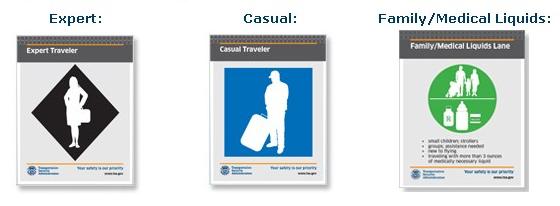So I just bumped into Amy Jo Kim’s Gamification Workshop 2010 slides (via Sebastian Deterding). Amy Jo Kim is another of my professional crushes (she’s awesome), and there’s loads of goodness in the slides, but my favorite bit was based on this image about the Player’s Journey:
 (Image from Amy Jo Kim’s book “Community Building on the Web“).
(Image from Amy Jo Kim’s book “Community Building on the Web“).
She talks about how each of the different levels has different needs from a gaming system:
- Novices need onboarding – welcome, goals and process
- Experts need fresh content, activities and people
- Masters need exclusive activities, access and unlocks
This is possibly the most useful thing I’ve ever seen about social media for learning. E-Learning tends to be a one-off experience. Little time or money goes to the progression of the experience because the experience begins and ends in one chunk.
Hoping they don’t hate us
In my experience, most e-Learning also tends to be aimed at novices, and we sort of just hope that experts don’t hate us too much as they are compelled through the material. That’s about as much fun as being the experienced flyer standing in the TSA security line with your laptop out, liquids in a bag, shoes off and carry-on ready to go, trapped behind what appears to be a Grandma who hasn’t flown since 1972 and an entire daycare of small children with all the associated paraphenalia*.

But as (hopefully) we are slowing wrenching ourselves out of that model, and moving towards more integrated learning resource systems, we’ll have to take into account the differing needs of our learners, and how to engage them and meet their needs.
I’m in the process of thinking through ways to steer away from one-size-fits-all-ism for learning applications (yes, scenario-based learning is *great*, but it’s not the answer to all learning needs). I read another post this morning on why Gagne’s 9 Rules of Instruction are dead, which describes why those rules are entirely inappropriate for just-in-time learning. The writer is absolutely correct in those circumstances (Gagne’s 9 Events still have their uses for other things, but that’s another blog post).
So what have you seen?
What kinds of resources / systems / models are you aware of that give specific recommendations based on the circumstances or learner charactistics? I’m on a hunt and would be eternally grateful for anything you could point me to.
A few resources:
- There’s some stuff like the Dreyfus model to address different levels of learners (there’s a nice post on the Dreyfus Model here from Sumeet Moghe that talks about ways to apply it).
- Simon Bostock reminded me the other day of the Cynefin Framework for looking at different systems.
Here are the complete slides for Amy Jo Kim’s presentation:
[slideshare id=5838005&doc=workshop-ny-101119140421-phpapp01]
*I’m not hating on parents who travel with small children. I think they are the bravest people I know.

I am also a big Amy Jo Kim fan, as well as a long-time fan of her husband Scott. This is a great post, thank-you. I wanted to add a few links to some of my old posts that touch on these topics as well.
http://headrush.typepad.com/creating_passionate_users/2005/02/the_users_journ.html
http://headrush.typepad.com/creating_passionate_users/2007/03/user_community_.html
http://headrush.typepad.com/creating_passionate_users/2005/02/spiral_learning.html
We created our books based on a three-act “hero’s journey”, combined with game design principles. However, I have quit talking about our game design influences because I am so horrified by the recent “gameification” trend. Amy Jo Kim is one of a few exceptions, but she understands that the heart of games is more than just points and badges. There is much cargo culting these days, “Games have badges and points, and games are compelling, so let’s slap badges and points on…” completely ignoring the fact that points and badges are *in service* to something else. It is that “something else” where the power lives, and without that, all you are left with is a temporary sugar high, or, the intermittent variable reward of slot machines.
But I am not bitter 😉
Agree. It’s about feeling awesome when you achieve a goal that is important to you. Game artifacts can be used to recognise achievements but unless people want to reach the goals you’re rewarding them for reaching, all the badges and points in the world are useless.
PS: Kathy is my idol.
Blair — that’s really the heart of the problem, isn’t? They are potentially useful as reinforcers (if handled very carefully), but they aren’t the point.
PS: Kathy is my idol.
Yeah, me too 🙂
Sigh, I know — the gamification carpet-bagging is horrifying, which is unfortunate because I still think there’s a lot of good there. I’m halfway through a “Why I still like gamification” blog post. I’ll have to finish it up and get it posted.
Still, the critiques I’ve been reading of it have been helpful for my thinking on the subject. In particular, I realized that i didn’t have fun high enough on my design list for serious gaming stuff. It was there, but lower down. Now “How is this *fun*?” moved up to the second spot on the design concerns list, right after “Is the learning material germane to the game play?”
Appalling, and I should have known better, but it’s a process.
Aside from that, these links come at an extremely good time for me. I know that I’ve read the in the past, but I needed the reminder for another project I’m working (Thank you!). I’ve been meaning to get a hold of you about permission to use a couple of quotes, but I’ll send a separate email about that when I have them all listed.
Good stuff. And you shamed me into posting this, which I’ve been sitting on since October. Ay ay ay.
http://hypergogue.net/2011/01/05/the-play-channel/
I think the game designers approach is just bottled awesome here. They just get Flow so well, without going all semi-mystical. And the unlocking business is just – hey, isn’t that how we ‘met’ on the internet, with the satnav thing?
Anyhoo.
I also finished off this one, which I’ve only been sitting on for a month or so…
http://hypergogue.net/2011/01/05/social-learning-and-the-exobrain/
In my head, as I rushed off to finish it, all excited by your post, it fitted in quite well with the above. But now I’m pretty sure the link’s in my head only.
But, basically, it’s this.
I’ve talked before with you about Cognitive Load Theory zealots’ tendency towards inculcation/indoctrination. It’s all very well to talk about ‘Instructional Design taking over the Executive Function’ but what if the learning is Cynefin complex, or there are unk-unks or play or or or or?
Plus, ‘ain’t no fool taking over MY Executive Function, I’m from Brooklyn etc
I think we’ve got ourselves into a minimalist blind alley. (I know CLT != minimalism, but it sure does look that way sometimes.)
On our recent Digital Learning project we’re experimenting with SHEDLOADS of content. And some of it is just plain wrong. Wwe’re adding ‘seasons’ and ‘stories’ and ‘layers’ over the top – if we do it right, learning will be a process of triangulation rather than absorption. Screw Shannon-Weaver, we’re adding in a whole load of ludic noise 🙂
Yep, we’re building a learning RPG.
But it’s also like some of the Future of News people things with their topic pages and news toys and Jason Fry’s approach to sports reporting (http://hypergogue.net/2010/07/16/mgt-is-beautiful/ – paraphrase – don’t write about the game, but treat the game as the most interesting thing that happened that day)
I know you like the word ‘exobrain’ – it’s about telling stories and providing a better Exobrain than the sprawling mess that Google and The Twitter have become.
Wow. I have come out of my chrysalis and turned into a star-struck evangelist. 🙂
More practically, this Zertify model (and the Boyer scholarship model) are aces:
http://hypergogue.net/2010/12/03/zertify-a-community-taxonomy-for-learning/
Yes, I know. I keep linking to my own posts. But I reckon they’ve hit on something there with Zertify. This is a blueprint for a good Exobrain…
You know I’m totally stealing the phrase “providing a better exobrain” right?
Scurrying off now to look closer at the zertify stuff…
Thank you for sharing your learnings on learning.
One of the interesting ideas on skill acquisition that I came across recently was the difference between L-Mode and R-mode thinking by Betty Edwards in her book “Drawing on the right side of the brain”. L-mode is basically the analytical, verbal thinking of everyday tasks. R-mode thinking is about intuition and pattern matching. Applying R-mode for drwaing gets you easily into flow experience. I can recommend to try the amazing experiments that are described in Edwards’ book.
Furthermore, nice differences between implicit and explicit knowledge can be seen in Eastern traditions. Nonaka describes the important processes of applying metaphors in innovation processes.
See some very rough summaries and ideas sketched in my blog:
http://pmulder.blogspot.com/2009/10/how-can-we-get-smarter.html
http://pmulder.blogspot.com/2011/02/implicit-and-explicit-knowledge.html
Thanks Patrick – glad you liked the post. Right brain / left brain is certainly a useful metaphor (even if it’s anatomically dodgy).
Haven’t picked up any Nonaka in a long time, but have been thinking about implicit / explicit lately. I’ll take a look!